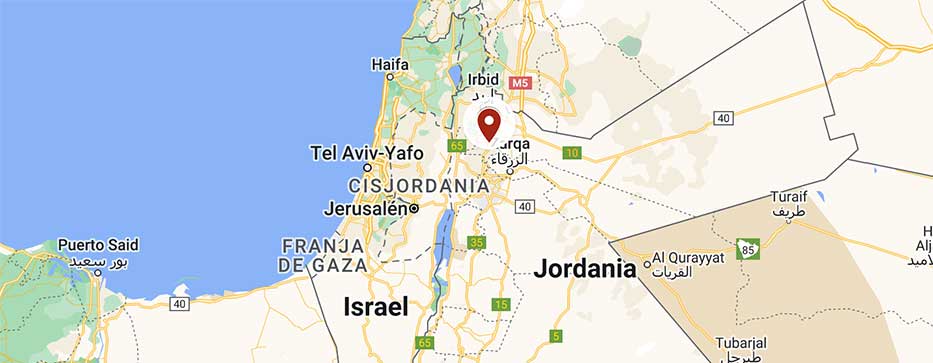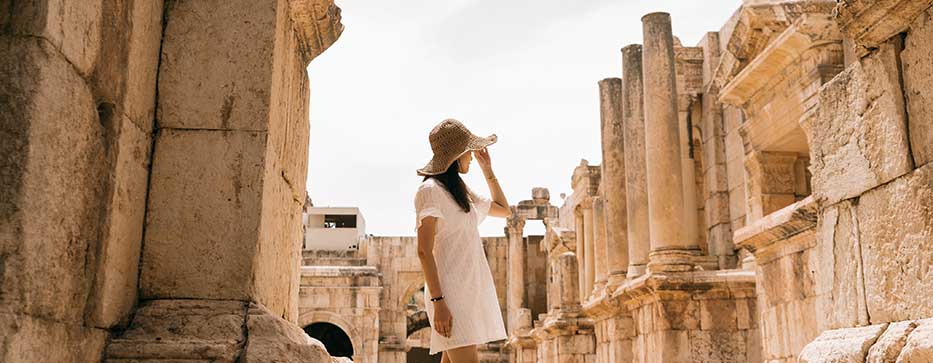Upon arrival, the visitor can see that in Jerash almost everything revolves around its past: the Roman vestiges that still stand are considered the best preserved in the country and even in the Middle East and all the territory that formed the Roman Empire.
For something this city, known as Gerasa in Antiquity, usually receives the nickname of the ‘Pompeii of the East’ or the ‘Pompeii of Jordan’. Jerash, in addition, it has been able to exploit its potential by enriching the visit with elements to interpret the heritage, such as an archaeological museum, and with activities related to that glorious period. On this page we tell you what to see in Jerash and we give you other information of interest that may be useful for your visit.
Jerash, capital of the governorate of the same name, is located in northern Jordan, about 50 km away from Amman and about 40 km from Irbid, the other large city in the region and second most populous in the country. The Syrian border is also 40 km away by road, while the nearest border crossing with Israel is 75 km away.
Its climate, like all of northern Jordan, is somewhat friendlier than in the rest of the country, with more fertile land and green areas in the nearby environment, largely because it enjoys a higher level of rainfall. In fact, its climate is classified as typical Mediterranean. It is no coincidence, therefore, that this is the most densely populated area in Jordan. Approximately, the highest average temperatures are around 31ºC in July and August, and do not fall below 4ºC in winter.

To better understand what to see in Jerash, it is essential to review its rich history, as it has left us abundant and spectacular vestiges, for the enjoyment of any traveler. It is known that already in the Neolithic, particularly during the Metal Age (IV millennium BC-II millennium BC), this territory was already inhabited, something that is not surprising considering that the Middle East was the epicenter of those civilizations.
After interpreting some inscriptions discovered on the ground, it is believed that Jerash was established as a city in the time of Alexander the Great, around 331 BC, when the great Hellenistic emperor was in the region, on his way to Mesopotamia after his passage through Egypt.
What is clear is that in the first century BC, Gerasa (as it was known in Antiquity) already existed, as it was conquered by Pompey (64 BC), military and strong man in Republican Rome.
Shortly afterwards it became part of what was known as the Decapolis: a sort of network of city-states (probably more than 10) that marked the confines of the Roman Empire in the East, enjoying an important autonomy (coinage) but deeply Romanized, adopting its traditional urbanism and the cult of the emperor. Other cities of the Roman Decapolis in present-day Jordan were Philadelphia (
Amman
) and Gadara (um Qais). Jerash or Gerasa flourished thanks to its rich agriculture and iron mining, establishing commercial relations with its environment, for example with the Nabataeans of Petra.
From 106 AD it enters a new phase: it is enlarged and reformed in the time of Emperor Trajan and, above all, Hadrian, who visited it personally. That was precisely why Hadrian’s Arch was erected, with which the city triumphantly welcomed the emperor. At the beginning of the third century, Gerasa reached its apogee and it is believed that it had 20,000 inhabitants.
Already in the fifth and sixth centuries, after the fall of the Western Roman Empire, the city continued under the rule of its Byzantine successors, who erected religious temples, as visitors can see in Jerash. today. In addition, in one of them there is evidence of Hebrew inscriptions, which suggests the existence of a small Jewish community at the time.
At the beginning of the seventh century it lived a short-lived Persian conquest, but especially from approximately 640, Gerasa was under Muslim rule: the Umayyad Caliphate, with capital in Damascus, which led to a new period of economic flourishing, as can be deduced from its remarkable local ceramic production.
That was interrupted by a devastating earthquake in the eighth century, which plunged the city into deep decline. In the twelfth century, the Crusaders settled in Jerash a garrison, reusing structures for military purposes, such as the Temple of Artemis. It was something ephemeral, because shortly after the Muslim rule was again restored, with Ayyubids, Mamluks and Ottomans, successively.
Some revival Jerash experienced at the end of the nineteenth century with the massive arrival of Circassian population, displaced from Russia. A parallel modern city began to grow, next to the Roman ruins. Since then, awareness of the great value of the place has increased, initiating numerous archaeological projects and, already at the end of the twentieth century, its integration into the great tourist circuits.

As you can imagine, most monuments to see in Jerash They are related to its Roman past, concentrated in a very unitary and compact archaeological site, which greatly facilitates the visit. These are the main places of interest within this archaeological site:
In addition to all these monuments to see in Jerash, within the visitable enclosure there is a small Museum, where pieces recovered from the archaeological site are exhibited. In it you can see statues, mosaics, ceramics and a wide collection of objects, all identified with their time and other details of their context.

Of course at such a large and well-preserved archaeological site, you’ll have plenty to see in Jerash.. But if you want to add other activities to your visit, you have some options at your fingertips. Special mention deserves the Jerash Chariots: demonstrations at the hippodrome, with horses and royal chariots, in the form of biga races, gladiatorial fights and other typical shows of ancient Roman civilization. They are usually a classic at weddings, but can also be rented or arranged for other private purposes.
At the leisure and cultural level, the great annual event is the Jerash Arts and Culture Festival , which has been held in July or August since 1981 in one of the theaters of the archaeological site. It includes dramatic performances, concerts and other cultural expressions, for an audience that is largely tourist. Most of them arrive from Amman, for which buses are chartered with special schedules that are better adapted to the program.
Beyond this, leisure offers, especially at night, are limited. In the modern city you can find relatively simple restaurants and a modest commercial offer, because we must bear in mind that the city itself is not very large: about 50,000 inhabitants.
A last proposal that can be cited is about 15 km south of Jerash: the Royal Jordanian Botanical Garden in Tal al Rumman, recently established. It is located in the vicinity of the King Talal Dam and its main objective is to preserve and recreate the typical flora of Jordan, not only of this region but also of others: therefore, areas of pines, junipers, deciduous oaks, pistachio trees and other species have been planted. In addition, it has a herbarium to catalog the great variety of herbs in the country.
The most common is to get to Jerash as an excursion from Amman, dedicating half a day or a full day. However, those most passionate about Roman culture can spend more than a day studying and discovering the archaeological park, which will force them to spend the night in one of the few hotels in the city.
In both cases, the most comfortable option is the vehicle, whether it is a taxi, a rental car or a private vehicle with a driver. The distance from Amman is 40 km and the journey time is usually around 45 minutes. On the other hand, if you want to travel here from other points further away from Jordan, this is an indicative table of distances and durations:
A possible alternative is the bus, as the main company JETT has a direct route from Amman, in a tourist service that reaches Jerash also to Ajloun. However, departures are not daily, so it is advisable to inform yourself before this possibility. In any case, the bus station is located at the foot of the archaeological park. Minibuses also depart from Ajloun and Irbid in the direction of Jerash, although with irregular schedules.
The archaeological park of Jerash It has its own visitor center, where tickets are sold to access the site. It serves as a tourist information office, with brochures and maps.
In the center of Jerash You will find pharmacies and right next to the archaeological park is located the hospital of the city. At the entrance and in the surroundings of the visitable enclosure you will find police, who offer service and help to foreign visitors.





